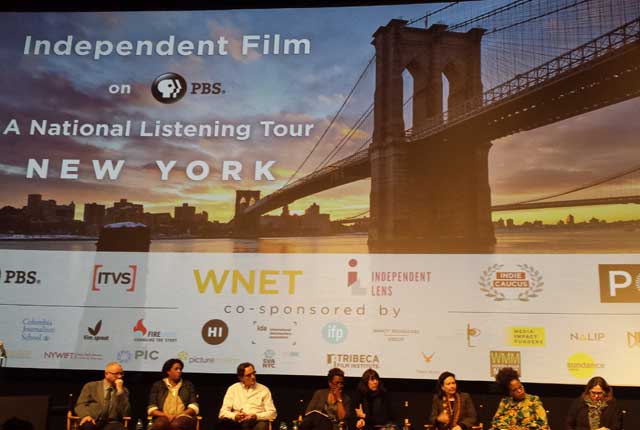"[Until] I went to a community screening of a [PBS] film called, "My American Girls: A Dominican Story" [in my early 20s], I had never seen myself on TV before," audience member Loira Limbal told public television VIPs at a filled-to-capacity New York City theater on Monday. "That was my first time seeing a film about people and stories and neighborhoods that looked like me."
Now, as director of Firelight Media’s Producers’ Lab, Limbal nurtures young filmmakers of color and her testimony was meant to help safeguard their future broadcast home. Whether PBS will continue to be that home is why filmmakers around the country are now protesting in addition to writing, directing and fundraising.
What follows are snapshots of the unfolding controversy and what it could mean for the communities that depend on filmmakers like Stanley Nelson ("The Black Panthers: Vanguard of the Revolution"), Byron Hurt ("Soul Food Junkies") and Julianna Brannum (" LaDonna Harris: Indian 101") to document their stories.
Why PBS is so important:
Because PBS regularly works with filmmakers of color. Indie films produced by and for public television are "markedly more diverse" than those produced for HBO, CNN or ESPN, according to a 2014 review of the year prior from the Center for Media & Social Impact at American University. Nearly one-third of "Independent Lens" directors were of color, for example, compared to none at CNN and ESPN and 13 percent at HBO.
The controversy, in a nutshell:
Traditional prime time hours are 8-11 p.m. WNET, the most-watched station in the PBS universe, decided last December to take "POV" and "Independent Lens"–the nation’s premiere showcases for indie documentaries–out of their prime-time slots on Mondays.It would air them in prime-time on WLIW, a smaller station with a smaller audience.
"POV" and "Independent Lens" would still run on the mammoth station, but on Sunday nights at 11, following it’s high-rating "Masterpiece" programs (think "Downton Abbey"). The move, WNET says, would likely boost viewership for the documentaries. Filmmakers, however, aren’t buying it. The move, they say, marginalizes their films by and about underrepresented communities because viewers won’t stick around to watch a documentary at 11 p.m. on a Sunday. (Nielsen reports that the fewest number of viewers are watching TV from 10:45-11 p.m.)
Why a single station, WNET, matters so much:
WNET, as it covers the New York City metro area, "sets the trend across the system," filmmaker Dawn Porter ("Spies of Mississippi") says. "From a Native filmmaker perspective, PBS has been our only friend," says Julianna Brannum, adding that "nobody" sees Native content elsewhere. "It shocks me that a station with that market size would consider pulling "POV" and "Independent Lens" [from prime time]," she says.
In other words, if the most-watched public television station in the most racially diverse metro area in the country pushes their indie documentaries to a secondary channel for prime time and Sunday at 11 for the mothership, filmmakers say that sends a powerful signal to other markets–that PBS, the home and developer of quality documentaries through "POV and "Independent Lens," no longer considers these films to be important.
But other markets don’t necessarily follow the NYC flagship either:
Porter says she was shocked to discover earlier this year that no films about black history, including her "Spies of Mississippi," would air in prime time in Washington, D.C., in February. "If we can’t be on during prime time in the nation’s capital during Black History Month then I don’t know when we can be on prime time," she says. The challenge however, as pointed out by PBS’ chief programming executive, Beth Hoppe, is that PBS’ roughly 350 member stations are largely autonomous. They air what they want, when they want. That explains why an award-winning indie film can air in prime time in one market, but during odd hours like 2 a.m., in another.
What the filmmakers want:
They say they want PBS to stay true to its public mission. And, more concretely, they want public television to mandate "common carriage," or that all stations accept a single prime-time programming schedule for "Independent Lens" and "POV." The current and constant time-slot switching makes it nearly impossible for filmmakers of color to promote their films and build an audience if viewers are forced to figure out when their documentaries will air. PBS, according to Hoppe, designates "only 500 programming hours for common carriage," annually.
Why the Internet isn’t the answer:
"There are more opportunities on-line, but that’s still a secondary option to broadcast," Brannum says. Broadcast reaches the largest viewing audience and PBS, according to Variety, has the fifth-largest English-language prime-time household rating behind CBS, NBC, ABC and Fox. And compared to the Internet, PBS’ demographics track more closely with the nation’s. What’s more, PBS has an enviable reputation among all Americans. That prestige and burnish of legitimacy is a big part of why indie filmmakers dream of being showcased through "POV" or "Independent Lens."
What’s next:
After the decision to move "POV" and "Independent Lens" drew such strong response, WNET decided to delay the schedule change. In the meantime, execs have started a four-month national listening tour to hear from creators. The tour has stopped in San Francisco and New York City; attention is now turning to Chicago’s meeting, which will take place in March. Stay tuned.
